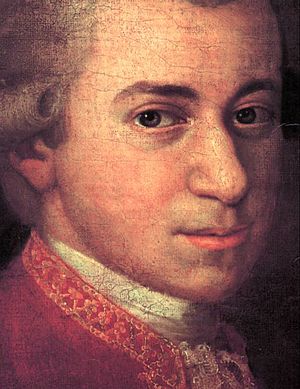Symphony No. 41 "Jupiter" (Mozart) facts for kids
The Symphony No. 41 in C major ("Jupiter"), K. 551 is a very famous piece of music written for an orchestra. It was created by the amazing composer Wolfgang Amadeus Mozart in 1788. This symphony is special because it was the last one Mozart ever wrote. It's often called the "Jupiter" Symphony, and it's one of his most well-known works.
Contents
What is the Jupiter Symphony?
Mozart's Symphony No. 41 is a long musical piece made up of four main parts, called movements. Each movement has its own mood and style. When Mozart wrote this symphony, he was living in Vienna, Austria. He finished it in just a few weeks during the summer of 1788. The "Jupiter" nickname was not given by Mozart himself. It was likely added later, possibly by a German musician named Johann Peter Salomon, because the music felt grand and powerful, like the Roman god Jupiter.
The Four Movements
A symphony usually has four movements, and the "Jupiter" Symphony follows this tradition. Each movement takes listeners on a different musical journey.
First Movement: A Dramatic Start
The first part of the symphony is full of energy and excitement. It begins with strong, bold sounds. You might notice that the music sometimes pauses suddenly, which adds to the drama. The tunes are often lively and change quickly, making the music feel very powerful and exciting right from the beginning.
Second Movement: Calm and Conflict
The second movement is much calmer and more peaceful. It has a beautiful, gentle melody that feels very relaxing. However, sometimes the music changes to a minor key, which sounds a bit sad or serious. These changes create a feeling of light and shadow, or calm and conflict, throughout this part of the symphony.
Third Movement: The Graceful Minuet
The third movement is a Minuet. A minuet is a type of dance music that was popular a long time ago. This part of the symphony feels very graceful and elegant. The music flows smoothly, and you can hear a special tune that seems to gently fall downwards. There's also a section called the "trio," which has a more earthy, dance-like feel. But even this part is sometimes interrupted by a sudden, serious burst of sound from the whole orchestra.
Fourth Movement: A Powerful Ending
The last movement is very complex and exciting. It uses a special musical technique called counterpoint. This means that several different melodies are played at the same time, weaving in and out of each other. This creates a lot of musical tension and excitement. All the different musical ideas come together in a powerful way, and the tension is finally resolved in the very last notes of the symphony, ending the piece with a grand finish.


